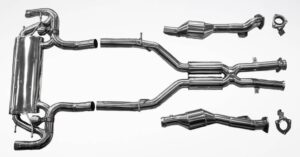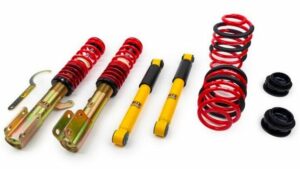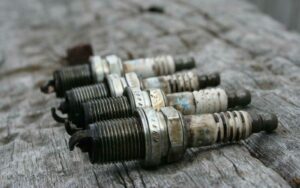Having the right type of system can make a lot of difference for your off-road truck/vehicle. Off-road vehicles can be modified in many different ways to achieve the owner’s personal style. Similarly, there are a lot of options for off-roaders when it comes to the exhaust system.
An exhaust system is one of the most important systems in a vehicle. It is like a breathing chamber for the vehicle; therefore, you must choose the best parts for an exhaust system.
A muffler is one such part of the exhaust system. To know which parts to choose for your tasks, you must know what each one does. Therefore, this guide will take you through all of the details regarding a muffler and how it affects your off-road experience. We will also go through how the muffler works and what’s the difference between a muffler in a regular car and a muffler in a four-by-four.
Table of Contents
The Purpose of a Muffler
Mufflers are part of the car’s exhaust system and usually run along the bottom of the vehicle. They are attached to the long steel exhaust pipes that protrude from the back of the car and release the gas. A muffler is supposed to dampen the sound made from the internal combustions of the vehicle’s engine. Without a muffler, the car would make a lot of sounds and would make everyone’s lives miserable around the vehicle.
Mufflers are made from steel and are usually coated in aluminum. The aluminum helps in protecting the devices from the chemicals released by the engine and the extreme heat that the cars release.
Every time the car’s engine is working, its pistons and valves make loud sounds. The engine’s combustion processes create bursts of gases, and this burnt gas produces loud sound waves. These gases are then released towards the car’s exhaust system, where the catalytic converter deals with the harmful gases while the muffler deals with the sound. The safe and quiet gases are then released from the car’s exhaust pipes.
To learn more about how a muffler works, you should go through the following two headings. They go into technical depth to explain how the muffler works. It is important to understand how it works in order to make sense of which muffler will be perfect for your off-road experiences.
Differences Between a Muffler and an Exhaust
There is a vivid difference between an exhaust, a muffler, and an exhaust system. Many people usually confuse these words and use them interchangeably when they are not supposed to be used like that. There is a specific meaning to each one.
So, the exhaust system is the system responsible for discharging harmful gas from the car safely and quietly. The exhaust manifold collects the harmful gas, and the exhaust pipes direct the gas into the catalytic chambers of the car. The gas is converted into a less harmful substance before being sent to the muffler.
So, to put it simply, the exhaust is responsible for collecting the gas and discharging it, while the muffler is just one component of the exhaust system and is responsible for dampening the sound of the gas created. It is helpful to remember that the word “muffler” can be used interchangeably with the word “silencer,” as it essentially silences the sound coming out from the car.
How Does a Muffler Work?
To go into the science of it, we are going to start from the basics and understand how a muffler works. The muffler actually dissipates the sound waves created from the combustion process. So, we’re dealing with sound waves, a series of high and low air pressures or vibrations. These vibrations are released along with the gas into the exhaust manifold.
Considering the laws of physics, a soundwave can be canceled out once it meets another soundwave of equal but opposite high and low air pressure areas. So typically, this means that when one wave is at its lowest point, the other is at its highest. Mathematically, their magnitude cancels each other, and you are left with silence.
Something similar happens inside the muffler. The sound wave enters the muffler, hits a back wall, goes through another chamber, and faces the entryway from where the sound waves are coming in. This happens in the resonator chamber. This chamber is designed to have a specific length to produce waves that cancel out the waves entering it. All other aspects of the muffler are also designed in order to aid the resonator’s functionality. The end goal is to cancel out the sound, and each specification made is to aid this goal. The walls of the muffler are also built to absorb pressure. Essentially, they absorb some of the sound waves. However, they are not efficient all the time, so you may hear some sounds from the back of your car from time to time.
It is important to understand the science aspect of mufflers as they will help you make a decision when it comes to buying the right one when you are upgrading. If the explanation is a bit difficult to understand, think of it this way: a muffler is a device that aims to control the sound waves so that they cancel each other out. In this way, their length and design are important and should not be messed with.
You can read more about mufflers and how they go with off-road trucks and vehicles in the next section.
Normal Exhaust vs. Off-road specific Exhaust
Mufflers and exhaust systems are built to suit each vehicle; therefore, it is difficult to pick any muffler and fit it with your truck. However, if you are looking for a specific muffler, then it will work for your project. However, there is a difference between normal exhaust systems and exhaust systems in four-wheel drives. So, you have to be careful when using mufflers suited for two-wheel drives for your four-by-four.
An exhaust system is important as it helps with the vehicle’s mileage and the sound and pollution aspects. Off-roaders look to improve their exhaust systems in two aspects. The first one is that off-road vehicles need sturdier mechanisms as the exhaust is usually on the underside and can face abuse from the terrain. The second aspect is the improved efficiency an exhaust can provide to the vehicle’s fuel consumption.
Some jeeps and almost all on-road cars have a normal exhaust system. When we refer to a “normal” exhaust system, we mean those systems that run all over the underside of the car and the mufflers are located close to the ground, and the pipes are all lower than most of the under-carriage components. Now, you can do off-roading activities with these mufflers, and some jeeps and trucks come with such systems. If there is not much of a terrain difference between where you are off-roading and a normal road, then you do not need to worry about getting an off-road exhaust system. However, if you are thinking of rock climbing, going near a river, or mud holing, it’s better to consider a truck with a built-in off-road mechanism in terms of an exhaust system.
You can consider installing a system yourself or moving the pipes around if you’re off-road vehicle does not have a built-in system. Essentially, the point of these two activities will be to protect the mufflers and pipes from getting hit by rocks and other things. The extension pipes, mufflers, and catalytic converters all need to be relocated into safer places so that you can avoid hitting them while carrying out your off-road activities. They can be relocated anywhere above the frame rails.
You can opt for two types of off-road exhaust systems if you are considering shifting from a normal exhaust system.
There is a “Rock Crawler” exhaust system. This system has bent pipes that run over the back axle. This means that the pipes are protected from rocks as they are above the undercarriage and at a safe distance from any attacks. These are great aftermarket systems, and you can install them yourselves also. All you need is some experience and knowledge about your car. However, if you do not feel comfortable, you can hire a mechanic. This method involves more labor and will be costly, but it will ensure that the work done will be of top quality.
The second popular system comes with “straight through mufflers.” This muffler increases performance and is more durable, so it can take some hits even at that position. It gives the vehicle’s performance an upgrade and can be installed manually as it is available as an aftermarket auto part.
Elements to Consider When Changing Exhaust Systems:
Pipe Size: The diameter of the pipes is important as their size determines if the engine’s power is being restricted or not. Smaller diameters restrict the flow of gases from the engine and force the engine to be less powerful. Larger diameters mess with the streamlined airflow of the engine and bring inefficiencies into the system. This means that the engine results in being less powerful.
So, if you are considering upgrading or changing the system yourself, then you must be careful not to change the diameter of any of the pipes from the size that was company fitted. This ensures that you are getting the maximum power out of your engine.
There are different pipe bending techniques, and one of them is mentioned above also, where the exhaust pipes bend over the back axle of the vehicle. However, the diameter is often times different at the bends because of inaccurate bending procedures. Be careful not to change the diameter of the pipes at the bends. Keeping a uniform diameter should be your goal when playing around with the exhaust system of your off-road vehicle.
Type of Off-roading: You also need to decide on how extreme your off-road activities will be before getting a muffler/exhaust system upgrade. For example, if there is not much of a difference between a normal road and your off-road terrain, then your rock sliders will take care of the flying rocks. However, if you aim to climb rocks and face a lot of bigger rocks, then you would have to protect your muffler. You would also need to get a snorkel exhaust if your vehicle would face a lot of water/rivers.
Material: Exhaust systems can easily be damaged by rust or the terrain. Therefore, you must be aware of the types of material that mufflers are available. You must choose a material that lasts long and does its job efficiently.
Primarily, mufflers come in steel and aluminum combinations; however, you can also get them in stainless steel. If you do so, it will obviously be an upgrade in comparison to steel. It will also cost a bit more. We say it is worth it to spend the extra cash on something like this as it is a lot of value for money.
Exposure to Toxins: You must also be aware that if you change the exhaust system yourself, then you will feel more vibrations in the cabin, and you might be exposed to more of the gas. Since the exhaust pipes usually tail at the back of the car, moving them might mean that the gas now enters the cabin as the tailpipe is now sideways. However, this is something you must be wary of and should consult an expert to help you with the shifting project.
Conclusion
All in all, mufflers are very compact and efficient devices that aim to reduce noise pollution levels across the world. However, they are used a bit differently by off-roaders, and this guide takes you through all the dos and don’ts of mufflers in off-road vehicles.




